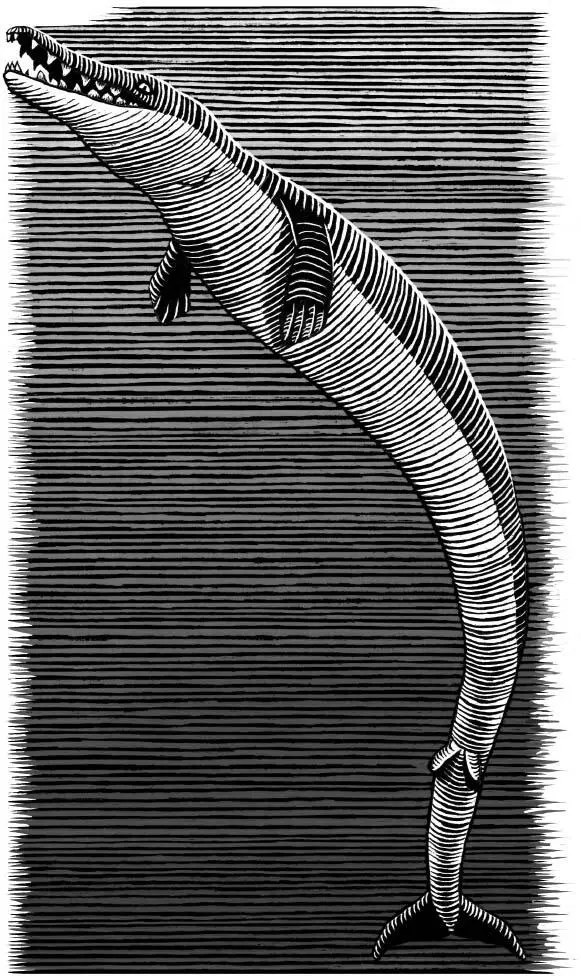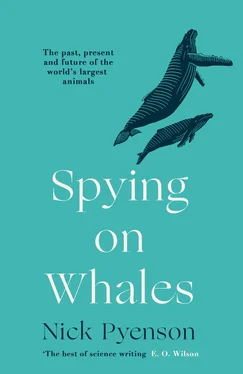The bonebed was essentially an exposed seafloor for several hundred thousand years, collecting the hard-part remnants of Miocene whales, sea turtles, sharks, and other animals that fell to the seafloor while lighter sediment swept past. Those few inches of bonebed today thus capture a condensed interval of time, between sixteen and fifteen million years ago—not much for a geologist but a span much longer than the duration of our own species. It’s also a span of time probably long enough to sample the full range of extinct whales and other backboned animals that lived in the vicinity of this part of California when the Central Valley was an embayment open to the Pacific. Knowing how many fossil whale species were around, giving them all scientific names, and understanding their evolutionary relationships is all ongoing work because there’s so little skeletal material to use as a basis for a species. (Kellogg used ear bones for most of his species, a puzzling move given how limited they are for species-specific identification.) Such work is time-consuming and exacting, measuring and comparing scraps of bone to one another. Many times we’re simply left saying, “This is something new, and it deserves a name, but we can’t say more until someone finds a good skull.”
Kellogg wrapped up his Sharktooth Hill work after finishing his dissertation and secured an appointment at the Smithsonian in Washington, D.C., where he turned his attention to fossil whales that were more complete, from an earlier time in whale evolutionary history. By the 1930s, the Smithsonian possessed the world’s most extensive collection of early whales, but they weren’t the land-dwelling ones, such as Pakicetus , whose skeleton still wouldn’t be found for another half century. Instead, there were drawers and drawers of Basilosaurus and other species of the first of the fully aquatic whales, more than enough to mount full skeletons for exhibit halls, and sufficient to know something about what these extinct whales were like.
Basilosaurus hardly seems like a whale—saying it’s almost like a whale would be charitable. It had a toothy, snout-dominated head, looking something like a gigantic leopard seal, except its nostrils were located not at the tip of its snout but about halfway farther back. It had a visible neck, unlike most of today’s whales. While its fingers and hands were probably encased in flesh, forming a paddle, it could bend its arms at the elbow, as no living whale can. The most remarkable thing about it was its long, eel-like body—most of its length came from its tail. Basilosaurus probably had a tail fluke, but it also had cartoonishly small hind limbs. These hind limbs were vestiges from its land-dwelling predecessors; as mentioned previously, they could not have held up Basilosaurus ’s enormous weight (about six tons) on land. In other words, Basilosaurus was fully aquatic, living its entire life underwater.
Kellogg knew only a little about those tiny hind limbs—the collections at the Smithsonian, for all their depth, still comprised only a pelvis and a single femur. Did Basilosaurus have feet? Toes? The answers to those questions eventually came from Basilosaurus skeletons found in Egypt, a world away from the coastal plain of the United States, and many years after Kellogg died.
Since the nineteenth century, paleontologists have known that the same strata used to build the pyramids of ancient Egypt harbor marine fossils, including fossil whales. These fossil-rich rocks crop out for nearly a hundred miles to the southwest of Cairo, exposed at their grandest scale in a place called Wadi Al-Hitan, loosely translated as “Valley of the Whales,” in the Fayum depression. Toward the end of the twentieth century, more detailed work in the area produced a species list including ten different early whales, along with early sea cows, primates, and the earliest elephant relatives. Wadi Al-Hitan, however, earned its name because of the fossil whales—especially Basilosaurus —whose skeletons number in the hundreds, spread across miles of desert expanse edged by cliffs and wind-battered mesas. These skeletons come from bonebeds, just in a different mode from Sharktooth Hill. Over three hundred skeletons of early whales are littered across one hundred square miles, including the first complete Basilosaurus skeletons ever found, with skulls, arms, rib cages and tail vertebrae, and legs—everything down to the four tiny toes intact. What these legs might have done in life, beyond being mere vestiges, remains unclear. (Some scientists have speculated that these small legs might have been used for copulation, especially given the animal’s extreme snakiness.)
Complete skeletons of Basilosaurus give us plenty of clues about its behavior. Like some of its predecessors, Basilosaurus had acoustically isolated inner ears, letting it hear directionally underwater, but it lacked the anatomical space to house any kind of echolocation organ on its face. ( Basilosaurus therefore heard only low-frequency sounds—not the ultrasonic ones that echolocating toothed whales use today.) It ate fish, based on fossilized stomach contents. Every tooth in the head of Basilosaurus was capable of crushing bone, and its overall bite force exceeded that of any other mammal, living or extinct, including hyenas. Bite marks on the skulls of another, smaller species of early whale from the Fayum suggest that Basilosaurus ate other whales, the way killer whales do today. One major difference with killer whales: Basilosaurus could crush its food, whereas killer whales rip and tear, oftentimes working together. At the moment, we can’t say whether Basilosaurus moved about in pods—there’s no good fossil correlate for that kind of behavior.

Basilosaurus
The fossil-rich rocks of Wadi Al-Hitan reflect ancient shorelines formed during episodes of periodic sea-level rise and fall at the end of the Eocene, around 40 million to 35 million years ago. Basilosaurus probably inhabited these lagoonal environments (it certainly was buried in them); it lived not unlike many dolphins do today, ranging from coastal shores to open water. By the time Basilosaurus went extinct, at the end of the Eocene, subsequent branches in the whale family tree leading to today’s whales had already evolved. While we don’t have a good fossil record for the very beginning of today’s echolocating and filter-feeding whales, we suspect they looked a fair bit like Basilosaurus —fully aquatic, though less snaky, sized-down shadows of the leviathans that they would later become, tens of millions of years later.
So much for the hows of fossil whales with legs. But why? What led whales to return to the water from land in the first place? That question takes us to the gap between the first and second phases of whale evolution, the gap that remains in the family tree between the branches leading to Maiacetus and Basilosaurus . In about ten million years, whales went from looking like the four-legged Pakicetus to something closer to Basilosaurus . Sometime during that interval (and probably in the last half of it), whales ambled and swam equal amounts, with shorter hind limbs and blowholes migrating backward along their snouts. And then, at some point, a generation of whales never emerged out of the water back onto land, and their descendants begat blue whales, humpbacks, sperm whales, dolphins, and every other living whale species (along with many extinct ones, like Kellogg’s finds from the Miocene).
Читать дальше













